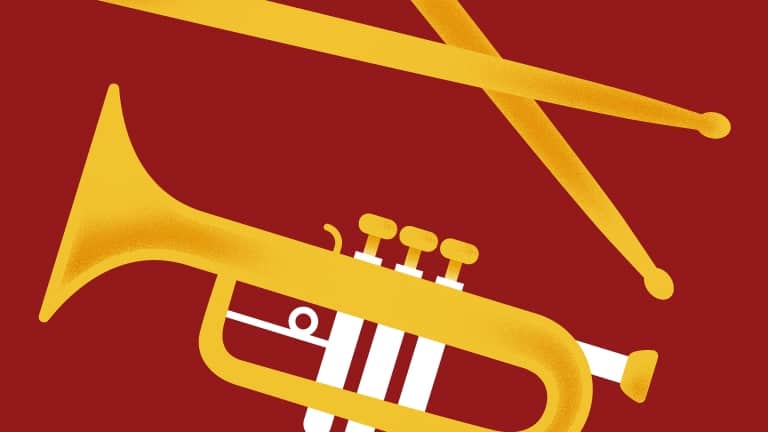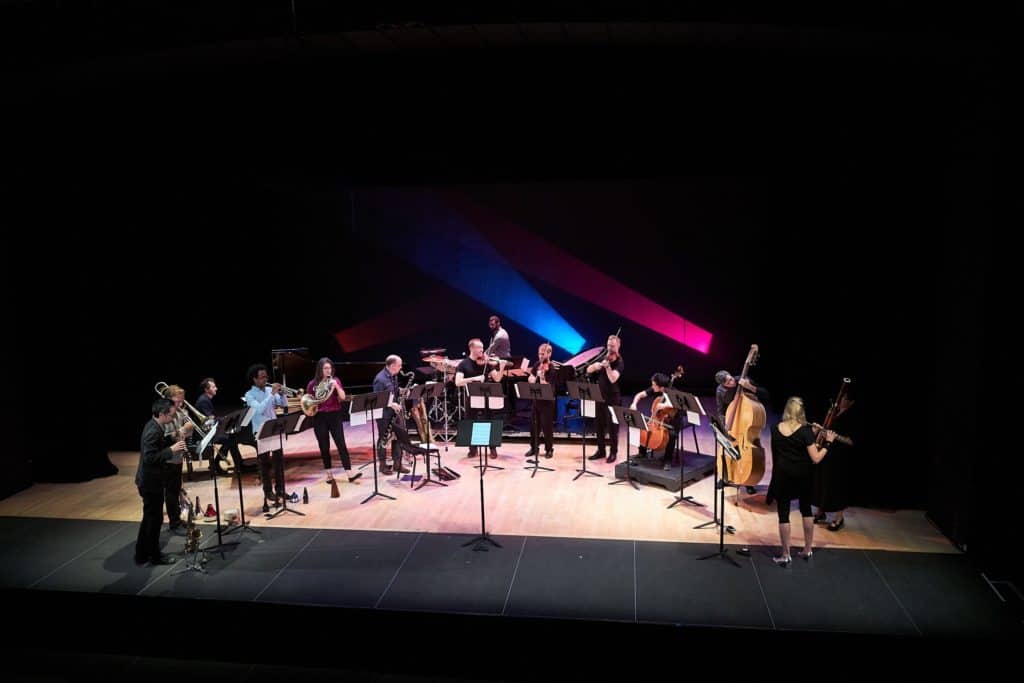What is jazz? The question isn’t philosophical, it’s practical—jazz is a practice. Jazz is just about 100 years old, with a give-or-take that depends on when your ears tell you musicians started playing it. The Original Dixieland Jass Band was the first group to record the music, in 1917, but they, and others, had been playing it for a considerable before the sessions at the New York studio of the Victor Talking Machine Company.
Jazz was a way to make ensemble music that came out of a mix of other musics, including the blues, ragtime, marches, dance styles like the cakewalk, Tin Pan Alley songs, Afro-Cuban rhythms. This diverse mix of the music of ordinary people, music heard in the streets and the brothels, the saloons and vaudeville stages, makes it the most American of art forms, built like the rest of this nation on the foundation of the racist enslavement of blacks, embraced by waves of ethnic immigrants, always outside the mainstream of establishment culture. Even at the height of its popularity, from the swing era up through hard bop and the modal jazz of the early 1960s, jazz maintained its outsider, hip stance. It’s the only music that started as pop music and then grew, via the bebop revolution, into an art music, without ever abandoning the sensuousness of rhythm and the meaning of the blues.
So that makes the annual 24-hour Ragas Live Festival at Pioneer Works a key jazz event, even though you’ll barely catch a hint of swing or bebop language. This year’s edition, held on the weekend of October 19-20, had a robust live audience joined by listeners around the world (it streamed live on WKCR via radio broadcast and the web), there to witness some of the finest contemporary Indian classical musicians and the jazz and quasi-jazz players who have a natural affinities for the styles and concepts of ragas.
The festival was bookended by two hybrid ensembles, Adan Rudolph’s Moving Pictures and Brooklyn Raga Massive. The two groups drew something of a long, rising line through the night and day.
Leading from his percussion set up, and also playing the sintir, Rudolph projected a relaxed, internalized demeanor, serious but unobtrusive. His set felt like the aftermath of a yoga session, with centered, fluid energy. Rudolph and his musicians, including the excellent violinist (and festival artistic director) Arun Ramamurthy, and guitarist Marco Cappelli, tossed out brief solo statements, but this was primarily an ensemble performance, the group maintaining a cool simmer and coalescing around trance-like grooves.
Brooklyn Raga Massive already have an important body of work that extends from jazz — a John Coltrane tribute — to the avant-garde new music of Terry Riley. Guitarist David Ellenbogen, a key organizer for both the band and the festival, introduced their concluding set by revealing that Riley is preparing something new for them, but since it was not yet ready, Ellenbogen and sitarist Neel Murgai made an adaptation of Riley’s In C, a joyous thing they called In D, the tuning pitch for the sitar.
In between, Ramamurthy played a biting fusion set with bassist Perry Wormtan and the excellent drummer/percussionist Sameer Gupta; Ellenbogen formed part of the quartet Crossroads, a rapturous and beautiful collaboration between Jay Ghandi and West African musician Yacouba Sissoko; and Murgai led his own ensemble with violinists Ramamurthy and Trina Basu, cellist Marika Hughes, and Gupta on the tablas. A hybrid band in every way, they finished the set with “Spaghetti Eastern,” a number Murgai described as being about a “funky, raga-singing cowboy.”
There were also sets from the great veena player Saraswathi Ranganathan and the sitar master Anupama Bhagwat, through which the Western listener glimpsed something of the ancient, rigorous, rich raga traditions. But the microcosm of the festival, how it showed the way any musical conversation, raga or otherwise, built on the kind of groove that had many bobbing their heads, rocking in place, or twirling at the back of the crowd speaks across cultures, languages, and geographic boundaries, was the quicksilver duet of drummer Dan Weiss and guitarist Miles Okazaki. Weiss, who studied tabla, plays jazz and heavy metal, is a key member of saxophonist Rudresh Mahanthappa’s Indo-Park coalition, rounded off by Pakistani guitarist Rez Abbasi. Unfortunately they weren’t on the program for this year, but maybe next.
Riley is also a good example of how jazz is such a fundamental way to make music. Again, it may be new, but the thinking goes back thousands of years, with roots throughout Africa, across the Middle East and into the Indian subcontinent. Riley’s great breakthrough, as heard in In C and parsed through Brooklyn Raga Massive, was to connect compositional techniques from the Western art music avant-garde with the universal experience of music not as logical argument but as sensuous experience, especially as eroticized dance and trance (for more on the latter, take a look at Ted Gioia’s new book, Music: A Subversive History, which is fascinating and invaluable). Riley (who will play at Terry Riley at 85, two nights of performances at Pioneer Works, December 20-21) has always been in touch with the basic and powerful pleasures of music, so mixing jazz, Indian music, Persian music, and more was never anything more than natural and intuitive to him, as it should be for all of us.
The contrast to all this, not so much unnatural a la Huysman’s Against Nature, but experimentally abstract, was the Anthony Braxton Composer Portrait that Miller Theatre at Columbia University presented on September 25. Braxton is a jazz musician and non-jazz composer, and has long been a controversial figure. The usual arguments around him go back to the first question, what is jazz, and is Braxton making it? But that’s the wrong question. There’s no doubt about Braxton’s jazz credentials; check out his Complete Remastered Recordings on Black Saint & Soul Note if you need convincing. What matters is understanding what kind of composer he is. Near a quarter-century teaching at Wesleyan produced a generation of musicians who revere him, and it can be hard to listen past their own influence.
The Composer Portrait confirmed what I have always felt about Braxton. His ambition is admirable and important: to reconcile the complexity of spontaneous constructions/improvisation with the formal logic of the Western art music tradition. That was the story of Third Stream jazz, and like that genre Braxton has had a few breakthroughs but has also hit a lot of dead ends, or else produced music that can’t reach the level of his rhetoric (this is especially true of his gigantic Trillium opera project, which combines some strong music with an incomprehensible, hermetic drama).
There were the usual exemplary performances at Miller, courtesy of pianist Richard Carrick, JACK Quartet, Either/Or ensemble, and saxophonist and conductor James Fei. But Carrick could not draw anything coherent out of the chattering and discontinuous Composition No. 1 for piano. Composition No. 17 and Composition No. 46 likewise didn’t produce any meaningful logic, though there were many lovely moments, especially in the former, where JACK flicked out the notes like objects gently colliding in zero gravity.
The musicians massed on stage for a group, simultaneous performance of Compositions Nos. 17, 18, 40(O), 101, 168, and 358. These are complex works, even more so when mixed, with subgroups of musicians coming together in the moment to realize one piece, while other groups find their ways to different compositions. This was less logic than it was community, or better it was a community of musicians making music based around a shared language. We are music-making creatures, that logic is always there within us, and while a composer can write down rules for realizing it, the best way is just to pick up our instruments and play together. And that’s jazz.











